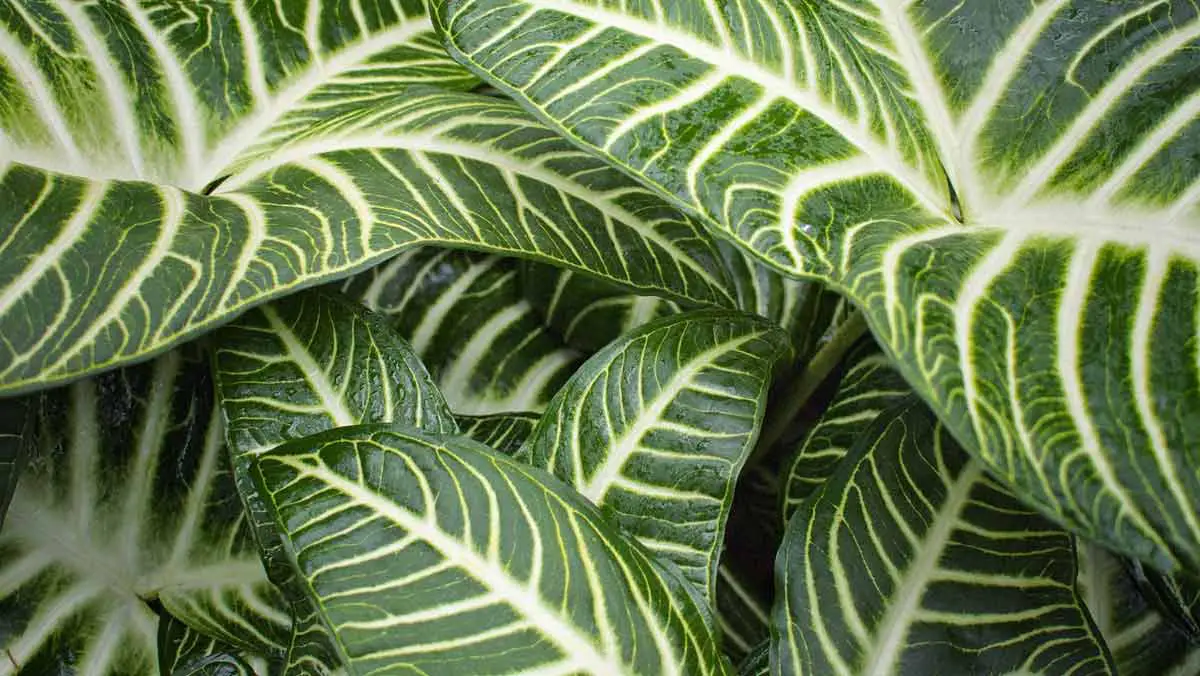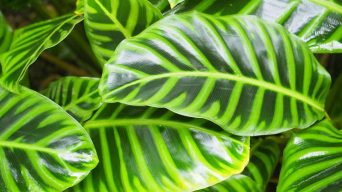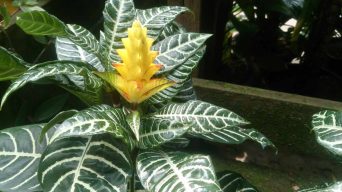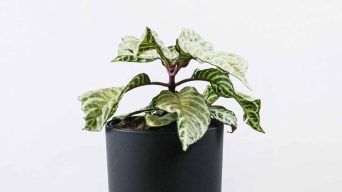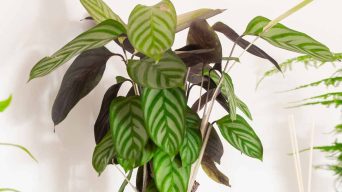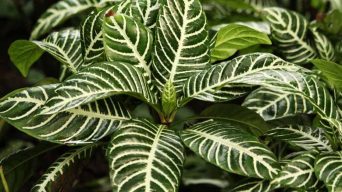Aphelandra squarrosa, commonly known as the zebra plant, is a tropical evergreen shrub native to Brazil. It typically grows to about 2-6 feet tall.
The zebra plant gets its name from the horizontal, white stripes adorn its dark green leaves. These beautiful leaves make the zebra plant a popular houseplant, but it can also be susceptible to problems.
One common problem is zebra leaves falling off.
If you are wondering why your zebra plant’s leaves are falling off, read on for some possible reasons and solutions.
What Causes Zebra Plant Leaves to Fall Off?
There are several reasons why zebra plant leaves may start to fall off.
Some of the most common include:
1. Overwatering
Overwatering is one of the most common reasons zebra plant leaves fall off. Zebra plants are native to tropical regions and prefer high humidity. However, they cannot tolerate soggy soils. If the soil is constantly wet or waterlogged, it can cause the roots to rot. This can lead to several problems, including leaf drop.
To prevent excessive watering of your zebra plant, make sure to let the soil dry out a bit before the next watering.
The best way to check is to stick your finger in the soil. If it feels moist, then you don’t need to water it.
2. Underwatering
Although overwatering is a more common problem, underwatering can also cause zebra plant leaves to fall off.
Zebra plants need regular watering to stay healthy but cannot tolerate drought conditions. If the soil gets too dry, it can cause the leaves to drop.
To avoid underwatering your zebra plant, make sure to water it regularly.
Zebra plants must be watered about once a week or when the soil is dry.
3. Nutrient Deficiencies
Zebra plants need nutrients to stay healthy and grow. However, they are especially susceptible to iron deficiencies. If your zebra plant doesn’t have enough iron, it will start to produce new leaves that are small and pale. These leaves may eventually fall off.
To prevent nutrient deficiencies, make sure to fertilize your zebra plant regularly. Use a fertilizer that is high in iron and other essential nutrients.
4. Extreme Temperatures
Zebra plants are tropical plants and prefer warm, humid conditions. However, they can also tolerate some cooler temperatures.
If the temperature gets too cold, it can cause the leaves to fall off.
Keep your zebra plant in a warm, humid environment to avoid this problem. The ideal temperature is between 60-85 degrees Fahrenheit.
5. Not Enough Light
Zebra plants need bright indirect light to stay healthy. If they don’t get enough light, they may start to produce new leaves that are small and pale. These leaves may eventually fall off.
To avoid this problem, place your zebra plant in a sunny location. An east- or west-facing window is ideal because it will provide the plant with bright indirect sunlight.
6. Too Much Sunlight
Although zebra plants need bright light, they cannot tolerate direct sunlight. If the leaves are exposed to too much sun, they may start to turn yellow or brown and eventually fall off.
To avoid this problem, place your zebra plant in a location that doesn’t get direct sunlight. An east- or west-facing window is ideal because it will provide the right amount of light.
7. Soil Issues
The type of soil you use can also affect your zebra plant.
Zebra plants prefer loose, well-draining soils. If the potting soil is too dense or doesn’t drain well, it can cause the roots to rot. This can lead to several problems, including leaf drop.
To avoid this problem, make sure to use loose, well-draining soil. To improve drainage, you can also add some perlite or sand to the soil.
8. Pests
Pests can also cause zebra plant leaves to fall off. Aphids, mealybugs, and spider mites are all common pests that attack zebra plants.
These pests suck the sap from the leaves, which can cause the leaves to turn yellow or brown and eventually fall off.
To control pests, regularly inspect your zebra plant for signs of infestation. If you see any pests, you can remove them by hand or treat the plant with insecticide soap or neem oil.
9. Diseases
Diseases can also cause zebra plant leaves to fall off. Common diseases that affect zebra plants include root rot, leaf spot, and powdery mildew.
Root rot is caused by fungi that attack the roots. The roots will start to rot and turn brown or black. This can kill the plant and cause the leaves to fall off.
Leaf spot is caused by fungi or bacteria that attack the leaves. The leaves will start to develop spots that are brown or black. These spots can eventually lead to leaf drop.
Powdery mildew is caused by fungi that attack the leaves. The leaves will start to develop a powdery white or gray growth. This growth can eventually lead to leaf drop.
To avoid diseases, plant your zebra plant in well-draining soil. You should also avoid overhead watering and instead water the plant at the base.
If you see any signs of disease, you need to remove the affected leaves and treat the plant with a fungicide.
10. Transplant Shock
Transplant shock is a common problem that can cause zebra plant leaves to fall off. Transplant shock occurs when a plant is transplanted from one location to another.
The plant may experience several stressors during the transplant, which can cause the leaves to fall off.
To avoid transplant shock, choose a well-lit location for your zebra plant. You should also acclimate the plant to its new location by slowly moving it into brighter light over a week.
You should also water the plant regularly and fertilize it monthly to help it recover from the transplant.
Following these tips can keep your zebra plant healthy and prevent the leaves from falling off.
11. Natural Leaf Drop
Finally, it’s important to note that some leaf drop is natural and nothing to worry about. Zebra plants typically shed their older leaves as new leaves grow in.
This is a normal process, and nothing to be concerned about.
If you see a few old leaves falling off, there’s no need to worry. But if you see a large number of leaves falling off, it could be a sign of a problem.
What To Do When Zebra Plant Leaves Fall Off
If you see zebra plant leaves falling off, you can do a few things to fix the problem.
Here are some tips:
Make Sure the Zebra Plant Is Getting Enough Light
Insufficient light is one of the most common reasons for zebra plant leaves to fall off. Zebra plants need bright indirect light to thrive. If the plant isn’t getting enough light, it will start to drop its leaves.
To fix this problem, choose a well-lit location for your zebra plant. You can also move the plant to a brighter place if necessary.
The best place for a zebra plant is near a west- or east-facing window.
To prevent the leaves from falling off, you should also acclimate the plant to its new location by slowly moving it into brighter light over a week.
Water the Zebra Plant as Needed
Another common reason zebra plant leaves fall off is too much or too little water. Zebra plants need to be watered regularly, but the soil should be allowed to dry out between waterings.
If the soil is constantly wet, it can lead to root rot, which can kill the plant and cause the leaves to fall off.
To water a zebra plant, you should use lukewarm water and water at the base of the plant. Avoid overhead watering, which can cause the leaves to drop.
You should also check the soil before watering to ensure it’s dry. You can do this by sticking your finger into the soil. If it’s dry to the touch, it’s time to water the plant.
If you’re unsure how often to water your zebra plant, you should check the soil every few days and water it as needed.
Fertilize the Zebra Plant During the Growing Season
Zebra plants need to be fertilized regularly to stay healthy. The best time to fertilize a zebra plant is during the growing season, which runs from spring to summer.
You should use a balanced fertilizer and apply it monthly according to the package directions.
Remove Dead or Damaged Leaves
If you see dead or damaged leaves on your zebra plant, you should remove them as soon as possible. Dead leaves can harbor pests and diseases, spreading to the rest of the plant.
To remove a dead leaf, you should use sharp pruning shears and cut it off at the base of the plant. Avoid pulling the leaf off, as this can damage the plant.
If you see damaged leaves, you can also remove them to prevent further damage to the plant.
Check for Pests and Diseases
Pests and diseases are other common reasons zebra plant leaves fall off. If your plant is infested with pests or diseases, it will start to drop its leaves.
You should regularly check your plant for pests and diseases to prevent this. Common signs of pests include chewing damage, sticky leaves, and webbing.
Common signs of diseases include yellowing leaves, spots, and mold.
If you see any of these signs, you should treat the plant as soon as possible. Various pesticides and fungicides are available that can kill pests and diseases.
You should also quarantine any new plants you bring into your home to prevent the spread of pests and diseases.
Provide the Right Temperature and Humidity
Zebra plants need to be grown in warm, humid conditions. The ideal temperature range for a zebra plant is 60-85 degrees Fahrenheit.
The ideal relative humidity level for a zebra plant is 60-70%.
If the temperature or humidity is too low, the zebra plant leaves will start to fall off.
To fix this problem, you should use a humidifier to increase the humidity around the plant.
You can also use a pebble tray, which is a tray filled with pebbles and water. The water will evaporate and increase the humidity around the plant.
You should also ensure the room where you’re growing the zebra plant is well-ventilated. This will help to prevent the leaves from falling off.
What Are The Benefits Of Zebra Plant Leaves Falling Off
While it may seem like a bad thing, there are some benefits to zebra plant leaves falling off.
One benefit is that it allows the plant to focus its energy on new growth. If the plant drops old, dead leaves, it can put energy into growing fresh, healthy leaves.
Another benefit is that it can help the plant to get rid of pests and diseases. If the plant is infested with pests or diseases, dropping its leaves is one way to get rid of them.
Finally, dropping leaves can help the plant to conserve water. If the plant loses water faster than it can replace, dropping its leaves is one way to prevent it from drying out.
While there are some benefits of zebra plant leaves falling off, it’s still a good idea to take steps to prevent it from happening. By following the tips above, you can keep your zebra plant healthy and prevent its leaves from falling off.
What To Do With Zebra Plant Leaves That Have Fallen Off
If you find zebra plant leaves that have fallen off, you can compost them. Zebra plant leaves are a great source of organic matter for your compost pile.
You can also use them as mulch around other plants. The leaves will help to retain moisture and prevent weeds from growing.
Finally, you can use zebra plant leaves as decoration. The leaves are beautiful and can add a touch of elegance to your home.
No matter what you do with them, zebra plant leaves that have fallen off can be reused in some way. So, don’t throw them away – compost them, use them as mulch, or use them as decoration.
Final Thoughts
Even if you’re the most attentive plant parent, sometimes zebra plants drop leaves.
If it’s just a few leaves here and there, it’s probably nothing to worry about. But if your plant is losing a lot of leaves or the leaves are dropping faster than they’re growing, it could be a sign of a problem.
In most cases, leaves falling off zebra plants (Aphelandra squarrosa) is due to too much or too little water, pests, or disease.
By figuring out what’s causing the problem and taking steps to fix it, you can help your plant get back to good health.

